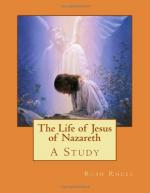60. Did Peter twice confess faith in Jesus as Messiah? Synoptics give his confession at Caeesarea Philippi (Mk. viii. 27-30; Mt. xvi. 13-20; Lk. ix. 18-21). John, however, gives a confession earlier at Capernaum (vi. 66-71). WeissLX III. 53 identifies the two, placing that in John at Caesarea Philippi, since there is no evidence that all of the long discourse of Jn. vi. was spoken in Capernaum the day after the feeding of the five thousand. This may be correct, yet the marked recognition which Jesus gave to the confession at Caesarea Philippi does not demand that he first at that time received a confession of his disciples’ faith. The confession in Jn. vi. 68, 69 declared that the twelve were not shaken in their faith by the recent defection of many disciples. At Caesarea Philippi the confession was made after the revulsion of popular feeling had been made fully evident, and after the twelve had had time for reaction of enthusiasm consequent upon the growing coldness of the multitudes and active opposition of the leaders. The confession of Caesarea Philippi holds its unique significance, whether or not Jn. vi. 68 is identified with it.
61. The journey to Tabernacles (Jn. vii.). Where in the synoptic story should it be placed? Lk. ix. 51 ff. records the final departure from Galilee. The journey of Jn. vii. is the last journey from Galilee given in John. Yet the two are very different. In John, Jesus went in haste, unpremeditatedly, in secret, and unaccompanied, and confronted the people with himself unexpectedly during the feast. In Luke (Mk. x. 1 and Mt. xix. 1 are so general that they give no aid) he advanced deliberately, with careful plans, announcing his coming in advance, accompanied by many disciples, with whom he went from place to place, arriving in Jerusalem long after he had set out. The two journeys cannot be identified. John seems to keep Jesus in the south after the Tabernacles, but his account does not forbid a return to Galilee between Tabernacles and Dedication (x. 22). After the hurried visit to Tabernacles, Jesus probably went back to Galilee, and gathered his disciples again for the final journey towards his cross—for the visit to Jerusalem had given fresh evidence of the kind of treatment he must expect in the capital (Jn. vii. 32, 45-52; viii. 59). See AndLOL 369-379. Andrews suggests that the feast occurred before the withdrawal to Caesarea Philippi (376); this is possible, but it seems more natural to place it during the sojourn in Capernaum after the return from the north (Mk. ix. 33-50). See SB, sects. 82-85.
62. On the phenomena and interpretation of Demoniac Possession see J. L. Nevius, Demon Possession and allied Themes; Conybeare, Jew. Quar. Rev. VIII. (1896) 576-608, IX. (1896-7) 59-114, 444-470, 581-603; J. Weiss in Reaelencyklopaedie,^3 Hauck-Herzog, IV. 408-419; Binet, Alterations of Personality, 325-356; James, Psychology, I. 373-400; and the articles on DEMONS in EnBib and HastBD.




